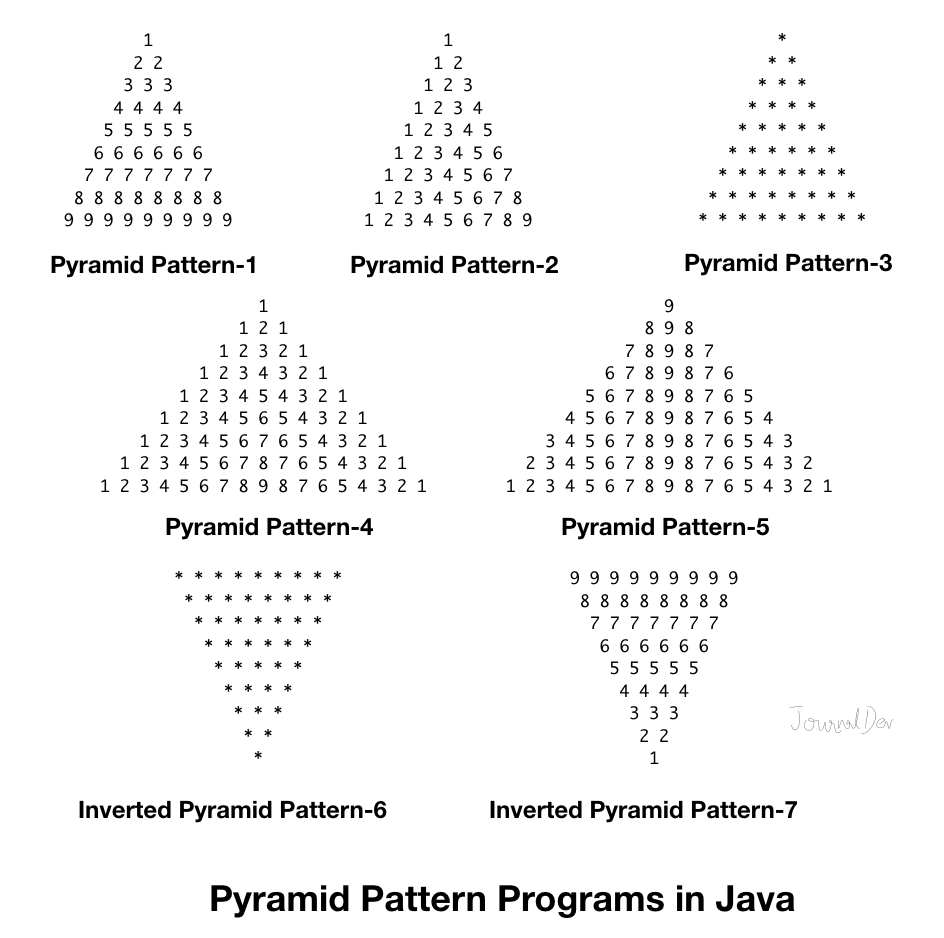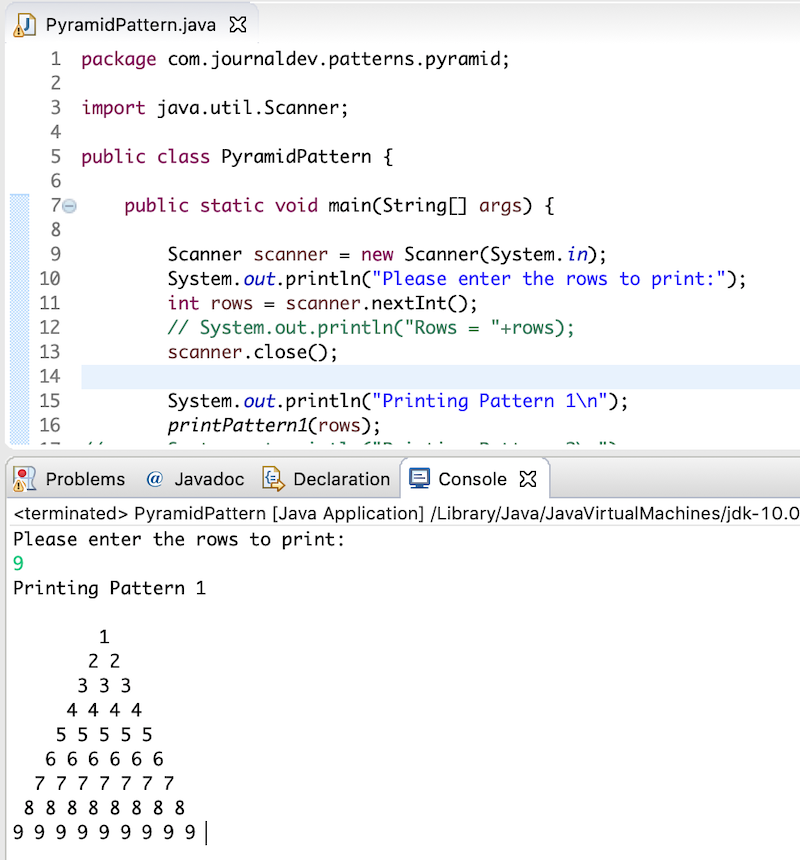Pyramid Pattern Programs in Java
Pattern programs are used a lot in interviews to understand the logical thinking abilities of the interviewee. Pyramid patterns are very popular and once we get the logic on the way it’s created, writing code to achieve the same is an easy task.

Here I am providing some examples to create different pyramid patterns from numbers, symbols etc. We will also look into some examples of creating inverted pyramid pattern in java program. We will try to keep the code simple so that it can be easily understood.
Pyramid Pattern of Numbers
If you look at the first pattern, every row contains the same number printed the same number of times. However, every row has leading white spaces whose count is “rows-i”. Let’s look at the program to print this pattern.
package com.journaldev.patterns.pyramid;
import java.util.Scanner;
public class PyramidPattern {
private static void printPattern1(int rows) {
// for loop for the rows
for (int i = 1; i <= rows; i++) {
// white spaces in the front of the numbers
int numberOfWhiteSpaces = rows - i;
//print leading white spaces
printString(" ", numberOfWhiteSpaces);
//print numbers
printString(i + " ", i);
//move to next line
System.out.println("");
}
}
//utility function to print string given times
private static void printString(String s, int times) {
for (int j = 0; j < times; j++) {
System.out.print(s);
}
}
public static void main(String[] args) {
Scanner scanner = new Scanner(System.in);
System.out.println("Please enter the rows to print:");
int rows = scanner.nextInt();
// System.out.println("Rows = "+rows);
scanner.close();
System.out.println("Printing Pattern 1\n");
printPattern1(rows);
}
}
Notice that I have created a utility function for common string printing task. If you can divide your program into short reusable functions, then it shows that you are not only looking to write the program but also want to make sure of its quality and reusability. When we run above program, we get the following output.
Please enter the rows to print:
9
Printing Pattern 1
1
2 2
3 3 3
4 4 4 4
5 5 5 5 5
6 6 6 6 6 6
7 7 7 7 7 7 7
8 8 8 8 8 8 8 8
9 9 9 9 9 9 9 9 9

Pyramid Pattern of Increasing Numbers
Here is the function to print pattern 2. The key point to note is the number of leading white spaces and then the numbers are getting printed in increasing order.
/**
*
* Program to print below pyramid structure
* 1
1 2
1 2 3
1 2 3 4
1 2 3 4 5
1 2 3 4 5 6
1 2 3 4 5 6 7
1 2 3 4 5 6 7 8
1 2 3 4 5 6 7 8 9
*/
private static void printPattern2(int rows) {
// for loop for the rows
for (int i = 1; i <= rows; i++) {
// white spaces in the front of the numbers
int numberOfWhiteSpaces = rows - i;
//print leading white spaces
printString(" ", numberOfWhiteSpaces);
//print numbers
for(int x = 1; x<=i; x++) {
System.out.print(x+" ");
}
//move to next line
System.out.println("");
}
}
Pyramid of Characters
This is a really simple one, we just have to print the character without any calculations or manipulations.
/**
* Program to print following pyramid structure
*
* *
* * *
* * * *
* * * * *
* * * * * *
* * * * * * *
* * * * * * * *
* * * * * * * * *
*/
private static void printPattern3(int rows) {
// for loop for the rows
for (int i = 1; i <= rows; i++) {
// white spaces in the front of the numbers
int numberOfWhiteSpaces = rows - i;
//print leading white spaces
printString(" ", numberOfWhiteSpaces);
//print character
printString("* ", i);
//move to next line
System.out.println("");
}
}
Pyramid Pattern 4 Program
/**
*
* 1
1 2 1
1 2 3 2 1
1 2 3 4 3 2 1
1 2 3 4 5 4 3 2 1
1 2 3 4 5 6 5 4 3 2 1
1 2 3 4 5 6 7 6 5 4 3 2 1
1 2 3 4 5 6 7 8 7 6 5 4 3 2 1
1 2 3 4 5 6 7 8 9 8 7 6 5 4 3 2 1
*/
private static void printPattern4(int rows) {
// for loop for the rows
for (int i = 1; i <= rows; i++) {
// white spaces in the front of the numbers
int numberOfWhiteSpaces = (rows-i)*2;
//print leading white spaces
printString(" ", numberOfWhiteSpaces);
//print numbers
for(int x=1; x0; j--) {
System.out.print(j+" ");
}
//move to next line
System.out.println("");
}
}
Notice that every row has 2*r-1 numbers. So we will have (rows-i)*2 whitespaces before we print any number. Then the numbers are starting from 1 to “i” and then to 1 again. Our logic to print the numbers would require two for-loops to achieve this.
Pyramid Pattern 5 Program in Java
/**
*
* 9
8 9 8
7 8 9 8 7
6 7 8 9 8 7 6
5 6 7 8 9 8 7 6 5
4 5 6 7 8 9 8 7 6 5 4
3 4 5 6 7 8 9 8 7 6 5 4 3
2 3 4 5 6 7 8 9 8 7 6 5 4 3 2
1 2 3 4 5 6 7 8 9 8 7 6 5 4 3 2 1
*/
private static void printPattern5(int rows) {
// for loop for the rows
for (int i = rows; i >= 1; i--) {
// white spaces in the front of the numbers
int numberOfWhiteSpaces = i*2;
//print leading white spaces
printString(" ", numberOfWhiteSpaces);
//print numbers
for(int x=i; x=i; j--) {
System.out.print(j+" ");
}
//move to next line
System.out.println("");
}
}
Inverted Pyramid Pattern of Characters
Here is the code snippet for the inverted pyramid program.
/**
*
* * * * * * * * *
* * * * * * * *
* * * * * * *
* * * * * *
* * * * *
* * * *
* * *
* *
*
*/
private static void printPattern6(int rows) {
// for loop for the rows
for (int i = rows; i >= 1; i--) {
// white spaces in the front of the numbers
int numberOfWhiteSpaces = rows - i;
//print leading white spaces
printString(" ", numberOfWhiteSpaces);
//print character
printString("* ", i);
//move to next line
System.out.println("");
}
}
Inverted Pyramid Pattern of Numbers
Let’s look at an example of inverted pyramid pattern made of numbers.
/**
*
9 9 9 9 9 9 9 9 9
8 8 8 8 8 8 8 8
7 7 7 7 7 7 7
6 6 6 6 6 6
5 5 5 5 5
4 4 4 4
3 3 3
2 2
1
*/
private static void printPattern7(int rows) {
// for loop for the rows
for (int i = rows; i >= 1; i--) {
// white spaces in the front of the numbers
int numberOfWhiteSpaces = rows - i;
//print leading white spaces
printString(" ", numberOfWhiteSpaces);
//print character
printString(i+" ", i);
//move to next line
System.out.println("");
}
}
Conclusion
There are many types of pyramid patterns. The most important point is to understand the pattern in which numbers and whitespaces are organized. Once you are clear about the pattern, you can write code easily in Java or any other programming language too.


